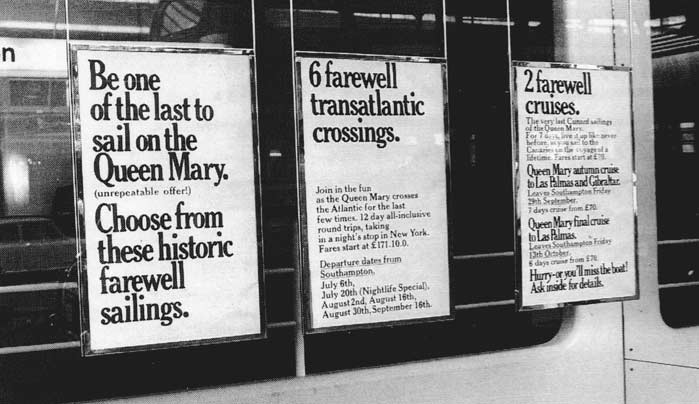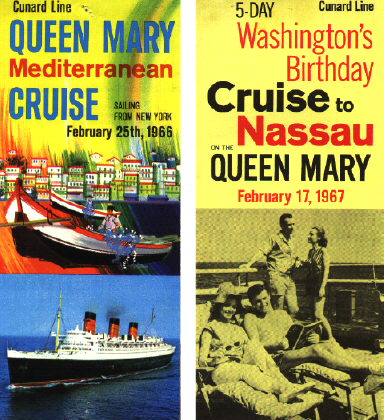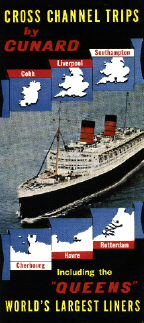
1958 was a very important year for the Queen Mary, for it was in this year that more people crossed the Atlantic by air than by sea. The writing was on the wall for the ship but Cunard still tried their best to make her run at a profit. To help reduce costs, her summer overhaul was omitted. The Mary had lost the Blue Riband to the liner SS United States in 1952, and was therefore no longer the fastest liner across the Atlantic.
Voyages on the ship could be lonely affairs at these times, especially in winter. In November 1961, the ship carried just 470 passengers on one particular trip, less than one quarter capacity. Crew outnumbered passengers by two to one.
In 1964, Four million people crossed the Atlantic by air. Cunard carried just 650,000 in all their ships. Something had to be done; something drastic, to make money for the Queens.
Cruising
In February 1963, the Queen Mary made her first pleasure cruise. Cruises to Las Palmas and Nassau became frequent, but the ship was unsuited to this role, and her lack of air-conditioning made passengers uncomfortable in hot weather. (The Queen Elizabeth was fitted with air conditioning in her last years at sea, but it never reached the Mary).

Posters advertising the last cruise


Brochure fronts from the ship's cruising days - late 1960s. The brochure on the right shows her calling at Cobh, and is quite rare.
The Queen Mary was also too big for cruising. She could not enter most of the ports she visited because of her size, and more importantly she could not go through the Panama canal. This is partly why the QE2 was designed to be so much smaller than the Mary. The QE2 only just fits through the canal with about 18 inches (45cm) on either side. The Queen Mary was also too thirsty, burning fuel at the rate of 1 gallon to every 13 feet travelled. She used about 1100-1500 tons of fuel per day. Today, by comparison, the QE2 uses about 250 tons per day.
As if that was not enough, the British Seamen's strike of 1966 cost Cunard millions of pounds in lost revenue, and by now the Queen Mary was losing £8,000 per day. Her schedule was altered to take in a call at Cobh, in Irelend, in the hope of attracting more passengers, but it made little difference.
This was the end. Both Queens were retired and quickly put up for sale in 1967. After opening sealed bids, Cunard announced that the Queen Mary had been bought by the City of Long Beach in California, USA. They had beaten the nearest (New York) bid by just $50,000, offering $3,450,000.
The Queen Mary had crossed the Atlantic 1001 times. She had sailed nearly 4,000,000 miles. It seemed there would be just one voyage left for her to make.